Research, Science and Conservation
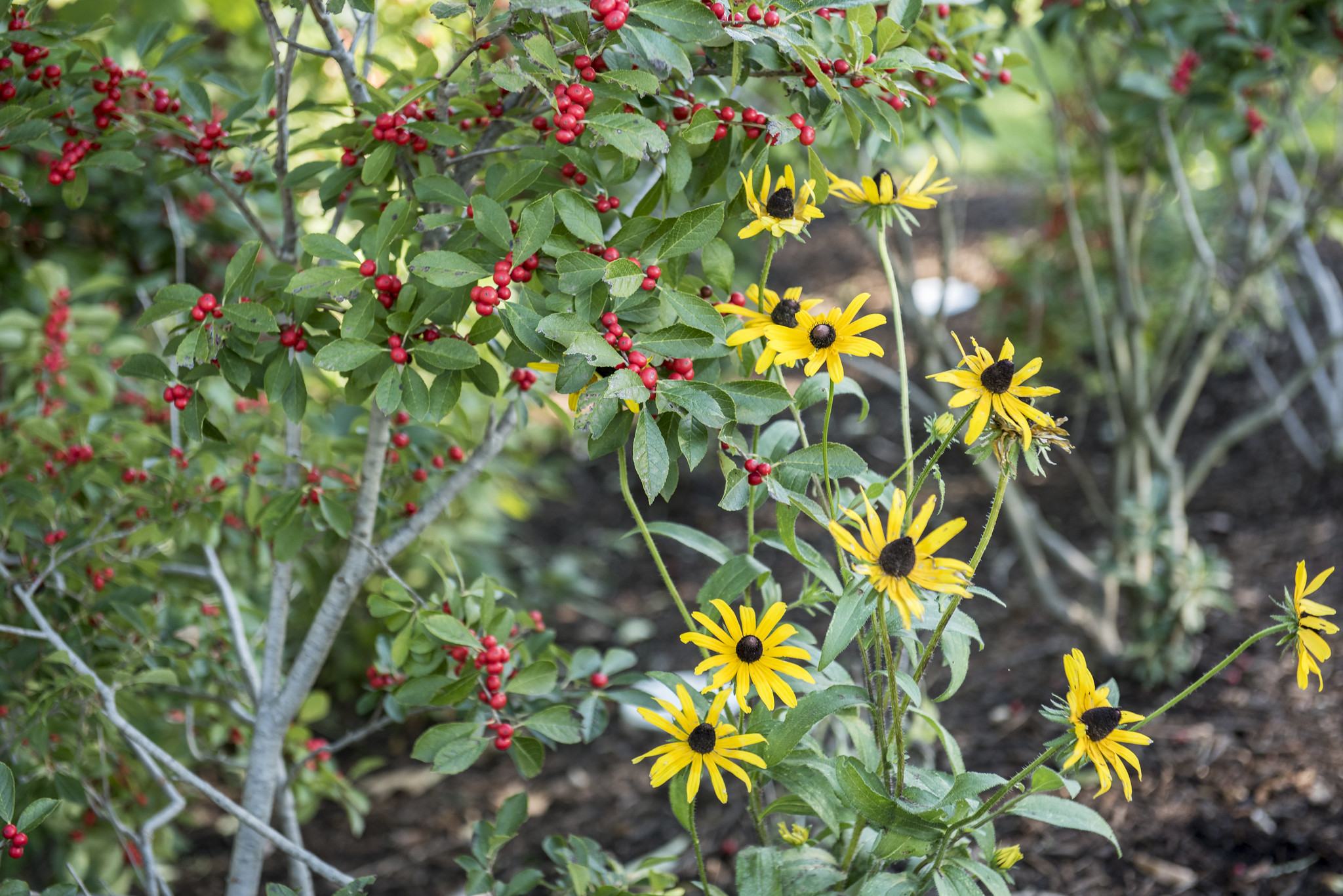
Ilex verticillata and black-eyed susans in one of Arlington National Cemetery's rain gardens.
The Arlington National Cemetery Memorial Arboretum has an active agenda related to tree science, strategic planting and conservation. The arboretum contributes to the arboretum community, tree science and urban forestry through several horticultural, ecological and conservation programs and projects.
Here are the projects that ANC’s Horticulture and Arboretum staff are currently working on. Please email arlingtoncemetery.horticulture@mail.mil if you would like further information on any of these projects.
TREE AND HORTICULTURE SCIENCE
Emerald Ash Borer (EAB) Trapping and Management
Following the initial detection of emerald ash borer (EAB) in the national capital region, ANC assisted the U.S. Department of Agriculture (USDA) and its Animal and Plant Health Inspection Service (APHIS) to establish and monitor EAB traps within the cemetery. These traps aid in detecting, quantifying and tracking the emerald ash borer population in Arlington County and Northern Virginia. The cemetery’s urban forester worked with the USDA team to select ash trees in the cemetery for trapping and also provided tree DBH (diameter at breast height), height and GPS data. During the trapping season, ANC’s urban forester checked the traps and reported findings and data to the USDA. Since these trapping efforts stopped, ANC has been treating the approximately 50 ash trees at the cemetery, including six progeny of green ash (Fraxinus pennsylvanicum) growing at Dwight D. Eisenhower’s birthplace.
ANC continues to treat the ash trees in the collection and shares results with arborists and forestry professionals.
National Boxwood Trials
 In the fall of 2009, 20 different species of boxwood were planted at different locations within the cemetery. Sites had different cultural conditions, such as light exposure and soil type. Each boxwood was photographed, the height and width recorded, and the locations mapped in the cemetery GIS system. As of May 2018, 39 individual plants of 13 cultivars remain.
In the fall of 2009, 20 different species of boxwood were planted at different locations within the cemetery. Sites had different cultural conditions, such as light exposure and soil type. Each boxwood was photographed, the height and width recorded, and the locations mapped in the cemetery GIS system. As of May 2018, 39 individual plants of 13 cultivars remain.
ANC horticulturalists evaluated the plants and rated for three main characteristics: grower friendliness, impulse cosmetics and susceptibility to leaf miner damage. The plants were given a rating of 1-5 for each of the characteristics. A rating of 5 meant the plant was determined to be easy to grow, had an impulse cosmetic effect of “wow,” or showed low susceptibility to leaf miners. A rating of 1 reflected that the plant was difficult or had died, had an impulse cosmetic effect of “ugly” or had a high susceptibility to leaf miners.
 Since the initial plantings were established in 2009, the fungal disease known as boxwood blight (Calonectria pseudonaviculata) has become a major pest problem for boxwood in the Mid-Atlantic region. As a result, the National Boxwood Trials project will now include an evaluation for blight resistance.
Since the initial plantings were established in 2009, the fungal disease known as boxwood blight (Calonectria pseudonaviculata) has become a major pest problem for boxwood in the Mid-Atlantic region. As a result, the National Boxwood Trials project will now include an evaluation for blight resistance.
The cemetery collected data again in 2013 and 2018.
► Click here for the complete National Boxwood Trials at Arlington National Cemetery Report 2018.
Pictured: Buxus microphylla "Jim Stauffer" in 2009 (left) and 2018 (right).
The American Chestnut Foundation Trial Saplings
ANC teamed with the Virginia chapter of The American Chestnut Foundation (TACF) to conduct growth trials of chestnut blight-resistant trees. In April 2011, TACF supplied two experimental trees for planting on the grounds of ANC. One of the saplings has survived and is monitored for signs of the chestnut blight (Cryphonectria parasitica), as well as other pests and overall growth rate. As of 2019, plans are underway at the Arboretum for the establishment of more American chestnut saplings that have been bred for both chestnut blight and Phytophthora root rot (Phytophthora cinnamoni). This project contributes to conservation efforts to reintroduce the American chestnut to its historical native range, which included the Arlington Estate and what is now ANC.
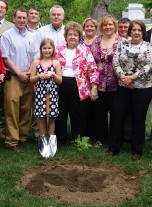

Chestnut sapling, April 2011. Chestnut, 2017.
In-Ground Crypt Study
 The ANC horticulture staff is playing a lead role in a partnership with the U.S. Army Corps of Engineers (USACE) to establish a study that compares the design and configuration of in-ground pre-placed crypts. Two test plots were established in April 2018 to compare two soil types and two soil depths in order to assess soil and water requirements for sustaining visibly healthy turf over pre-set crypts. The main objectives of the study were to determine the optimal soil type and depth, and to determine if viable turf grass can be sustained without the addition of in-ground irrigation systems. The results of this study will not only guide the design of ANC’s Southern Expansion Project, but will also be available to other cemeteries in both the public and private sector.
The ANC horticulture staff is playing a lead role in a partnership with the U.S. Army Corps of Engineers (USACE) to establish a study that compares the design and configuration of in-ground pre-placed crypts. Two test plots were established in April 2018 to compare two soil types and two soil depths in order to assess soil and water requirements for sustaining visibly healthy turf over pre-set crypts. The main objectives of the study were to determine the optimal soil type and depth, and to determine if viable turf grass can be sustained without the addition of in-ground irrigation systems. The results of this study will not only guide the design of ANC’s Southern Expansion Project, but will also be available to other cemeteries in both the public and private sector.
As the nation’s premier military cemetery, ANC is at the forefront of cemetery design and construction. In addition, ANC is recognized as a leader in cemetery horticulture, arboriculture and grounds maintenance. The operations, visitation and setting of active cemeteries present challenges that are unique to cemeteries such as ANC that perform a large number of interments.
A significant and increasingly used interment system consists of in-ground, pre-placed crypts. This system allows cemeteries to maximize interment space and to decrease the amount of excavation required. In-ground, pre-placed crypt systems have been installed at other national cemeteries administered by the National Cemetery Administration (NCA) as well as at private cemeteries.
The pre-placed crypt study has the following goals:
- Determine the best soil type.
- Test different crypt designs under real cemetery conditions.
- Assess water requirements for sustaining healthy turf, and the potential for irrigation reduction and/or elimination.
- Operational impacts of a six-inch increase in soil depth.
The depth and density of turf roots will be determined by taking soil cores periodically during the test period and again at the conclusion of the study. During the course of the study, color and density of the turf grasses on each crypt will be photographed and ranked on a scale of 1 to 10, with 10 being the best color and the highest density. Soil density will be measured during and after initial construction, midway through the test period and at the conclusion. Differential settlements within each test cell will be quantified.
STRATEGIC PLANTING
Rain Gardens
ANC has installed several rain gardens that capture rain water during storm events. These rain gardens help protect the Chesapeake Bay by decreasing runoff and minimizing the entrance of nutrients, silt and trash into the stormwater system. Rain gardens are alternatives to impervious surfaces and turf areas. They contain thriving perennials, shrubs and trees that attract pollinators, birds and other wildlife. Native plant species are strategically planted to encourage pollinators to utilize the gardens at certain times during the season.
► ANC horticulturist Kelly Wilson and ANC environmental specialist Stacey Rosenquist co-authored an article for the Chesapeake Bay Program Journal’s Fall 2017 issue, “Constructing Rain Gardens to Attract Butterflies."
CONSERVATION
Invasive Species Mapping
In the spring of 2018, the Arboretum horticulture team, assisted by the ANC geo-spatial information systems (GIS) team, began the process of mapping invasive species growing in the forested natural areas at the north end of the cemetery. This area, originally delineated as Section 29, has recently been developed as part of the Millennium Project.
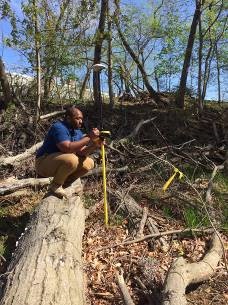 The site contains approximately 6.25 acres of mixed forest stands that range between 150 and 175 years old. The natural area abuts the “Arlington Woods,” which is managed by the National Park Service. The project area also includes a stream that was restored and planted with riparian plants.
The site contains approximately 6.25 acres of mixed forest stands that range between 150 and 175 years old. The natural area abuts the “Arlington Woods,” which is managed by the National Park Service. The project area also includes a stream that was restored and planted with riparian plants.
The mapping of the invasive plants is part of an overall invasive species management plan being developed by the ANC horticulture staff. The components of this plan are:
- Establish a baseline map, using GIS technology that identifies populations of invasive plants within the study area.
- Implement control and suppression methods.
- Track progress of control, suppression or spread of invasive plants.
- Detect new populations of invasive plants.
- Map populations of native plants to track natural and planted reforestation.
As areas of invasive populations reach a level of control and management that will allow native plants to occupy the areas with less competition, plantings will be installed to reforest the areas.
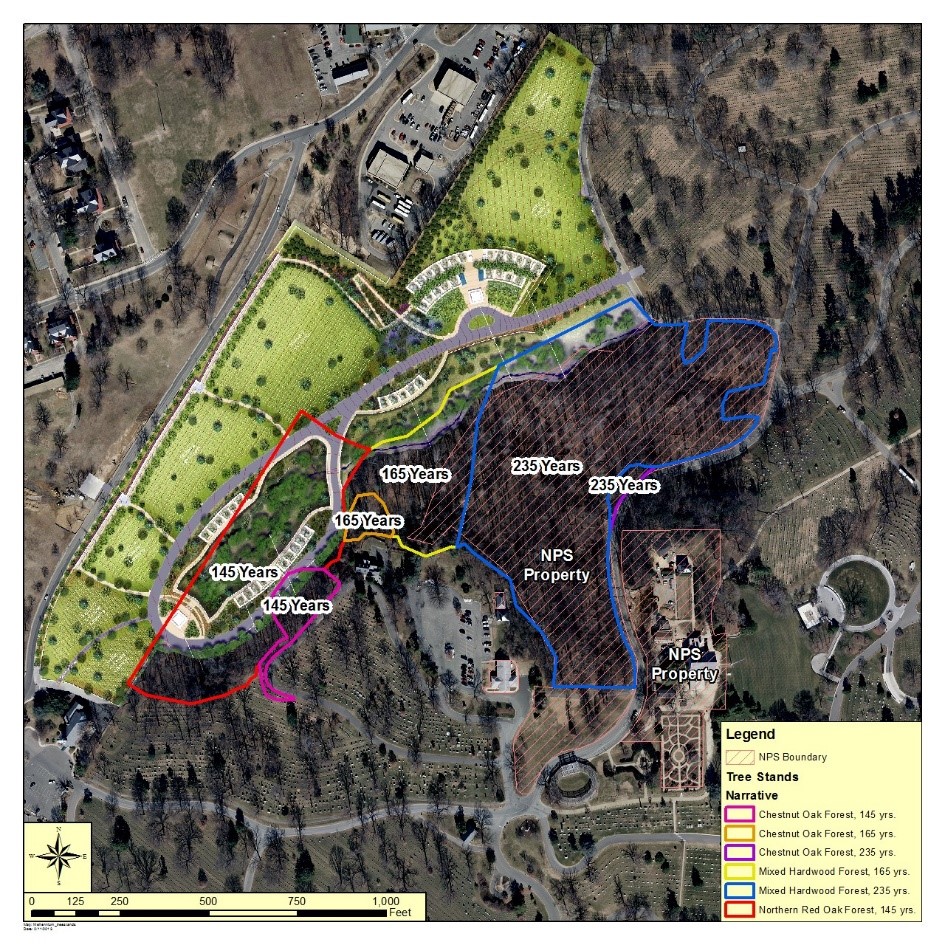
Millennium Project site plan with estimated ages of forest stands.
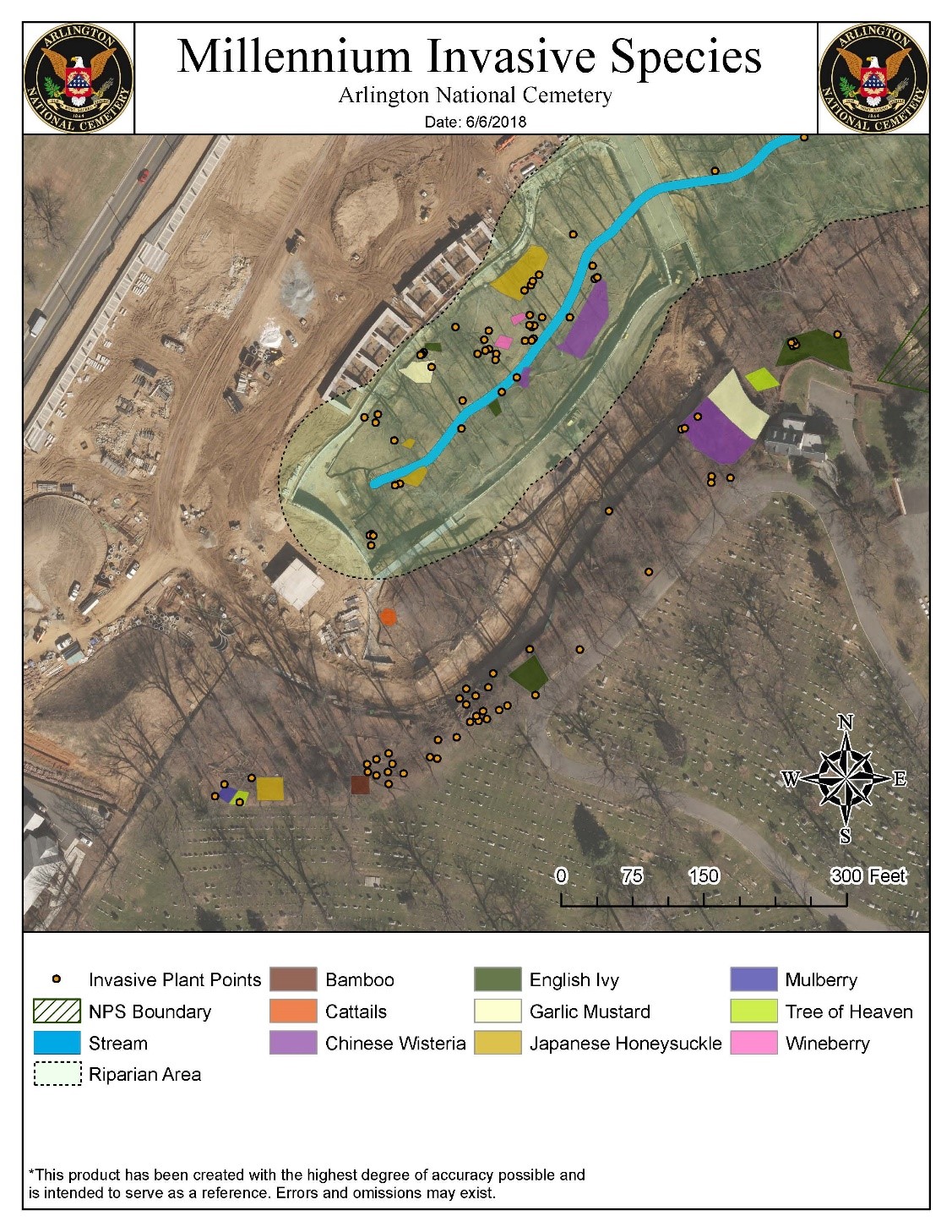 Invasive species mapping as of June 6, 2018.
Invasive species mapping as of June 6, 2018.
Seed Collecting
 ANC has teamed with the Potomac Conservancy "Tomorrow's Trees" program for more than a decade, allowing volunteers to access the cemetery to collect acorns, hickory nuts and other seeds. ANC Horticulture facilitates the Potomac Conservancy’s efforts by provide scouting information to the organizers: locations of tree species within the cemetery, areas of heavy seeding and other information. The Potomac Conservancy then propagates the seeds and plants the saplings at forest restoration sites throughout the Potomac River watershed.
ANC has teamed with the Potomac Conservancy "Tomorrow's Trees" program for more than a decade, allowing volunteers to access the cemetery to collect acorns, hickory nuts and other seeds. ANC Horticulture facilitates the Potomac Conservancy’s efforts by provide scouting information to the organizers: locations of tree species within the cemetery, areas of heavy seeding and other information. The Potomac Conservancy then propagates the seeds and plants the saplings at forest restoration sites throughout the Potomac River watershed.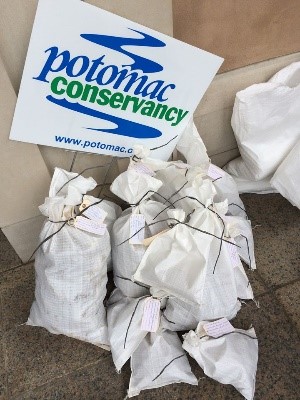
Each year, volunteers collect 200-400 pounds of seeds from many of ANC’s native trees and shrubs. Since 2007, over 3,000 pounds of acorns, hickory nuts and other native seeds have been collected at the cemetery.